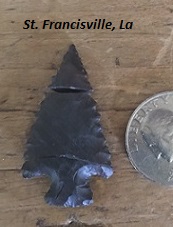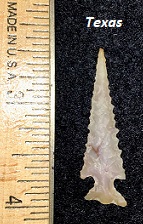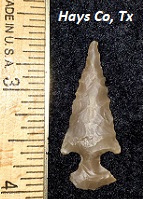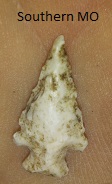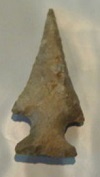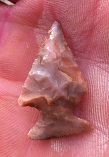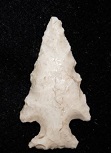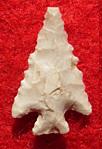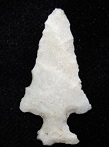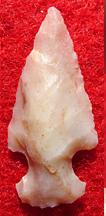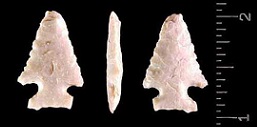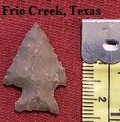Outline is Representative of Size and Shape:

Name Details:
Identified By: J Charles Kelley
Named For: Town of Scallorn, Mills County, Texas
Date Identified: 1947
Type Site: The Kyle Site, Hill County, Texas
Identified By: J Charles Kelley
Named For: Town of Scallorn, Mills County, Texas
Date Identified: 1947
Type Site: The Kyle Site, Hill County, Texas
Point Validity:
Valid type
Kelley was a distinguished anthropologist who served as Curator of the Archaeological Museum at the University of Texas-Austin and was instrumental in setting up the Department of Anthropology at the University of Texas-Austin. He specialized in the archaeology of western Texas. This type was named in a professional publication and has many professional references. This is considered a valid type.
Kelley was a distinguished anthropologist who served as Curator of the Archaeological Museum at the University of Texas-Austin and was instrumental in setting up the Department of Anthropology at the University of Texas-Austin. He specialized in the archaeology of western Texas. This type was named in a professional publication and has many professional references. This is considered a valid type.
Scallorn Corner Notch
Variations include: Means Corner NotchCluster: Scallorn Cluster
Description of Physical Characteristics and Flaking Pattern:
This is a thin small corner notch triangular point with a flattened cross section. The blade is primarily straight, but may be excurvate. An incurvate blade may be seen on examples that have a flaring shoulders edge. The blade may vary form broad to narrow. Many examples have a serrated blade. The shoulders are primarily barbed, and one of the defining characteristics, but some examples may have a square shoulder. The stem is expanding, and the base may range from straight to convex. This point has a random flaking pattern.
Size Measurements:
Total Length - 25 to 45 mm (average 23 mm) Stem Length - 5 to 9 mm (1/7 to 1/3 of the total length), Blade Width - 13 to 21 mm (average 16 mm), Neck Width - 5 to 11 mm, Stem Width - 7 to 18 mm, Thickness - 2 to 5 mm (average 5 mm).
Total Length - 25 to 45 mm (average 23 mm) Stem Length - 5 to 9 mm (1/7 to 1/3 of the total length), Blade Width - 13 to 21 mm (average 16 mm), Neck Width - 5 to 11 mm, Stem Width - 7 to 18 mm, Thickness - 2 to 5 mm (average 5 mm).
Commonly Utilized Material:
Additional Comments:
The Sequoyah point was originally classified as this type (Bell, 1960). The difference was recognized at the Williams Shelter site in Missouri and was later formalized and named by James Brown in 1968. Making the distinction between these two points may be difficult. The Sequoyah point is generally deeply serrated, have elongated blades, and a narrower hafting region with wider notches. (Justice, 1987).
This point is related to the Crisp Ovate (un-notched) point which is thought to have been the preform for the Scallorn and this point (Justice, 1987).
Kelley uses the name Scallorn Stemmed for the diagnostic point for the Austin Focus, but gives no description of the type. The point was later described by Miller and Jelks (1952) and a full description was provided in Suhm and Krieger, 1954.
The Sequoyah point was originally classified as this type (Bell, 1960). The difference was recognized at the Williams Shelter site in Missouri and was later formalized and named by James Brown in 1968. Making the distinction between these two points may be difficult. The Sequoyah point is generally deeply serrated, have elongated blades, and a narrower hafting region with wider notches. (Justice, 1987).
This point is related to the Crisp Ovate (un-notched) point which is thought to have been the preform for the Scallorn and this point (Justice, 1987).
Kelley uses the name Scallorn Stemmed for the diagnostic point for the Austin Focus, but gives no description of the type. The point was later described by Miller and Jelks (1952) and a full description was provided in Suhm and Krieger, 1954.
Distribution: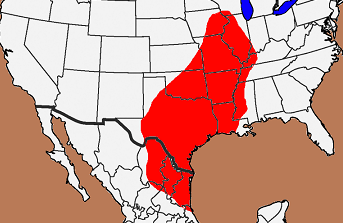

Distribution Comments:
This point is most commonly found in in central Texas throughout the Red River Valley of Texas, Oklahoma, Louisiana, Arkansas, The frequency decreased southward into Tamaulipas, Nuevo Leon, and Coahuila. It is found with less frequency in the other highlighted areas.
This point is most commonly found in in central Texas throughout the Red River Valley of Texas, Oklahoma, Louisiana, Arkansas, The frequency decreased southward into Tamaulipas, Nuevo Leon, and Coahuila. It is found with less frequency in the other highlighted areas.
Age / Periods:
Date: 1,300 - 500 B.P.
Cultural Period: Late Woodland to Mississippian
Glacial Period: Roman Warm to Little Ice Age
Culture:
Date: 1,300 - 500 B.P.
Cultural Period: Late Woodland to Mississippian
Glacial Period: Roman Warm to Little Ice Age
Culture:
Age Details:

